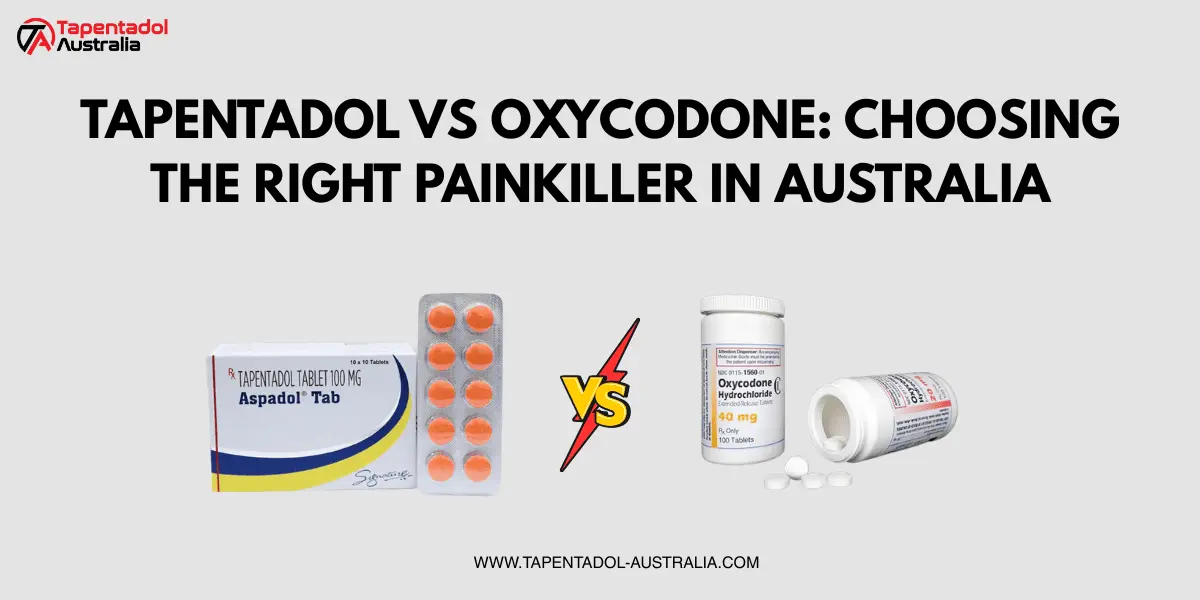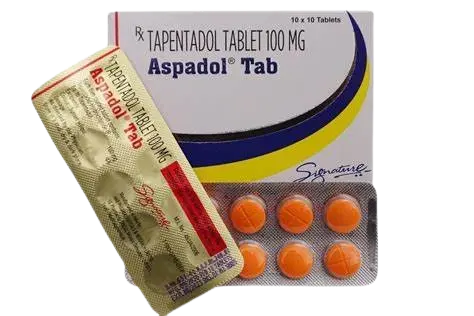Tapentadol vs Oxycodone: Choosing the Right Painkiller in Australia

In the debate between Tapentadol vs Oxycodone - which is better, there isn't a one-size-fits-all answer to the question. While Tapentadol seems like a safer option with less risk of dependence, Oxycodone has a better track record of effectiveness.Overall, it is crucial to break down the medications, your pain requirements, and other factors before arriving at a conclusion.
Quick overview: Tapentadol vs Oxycodone — what they are
Tapentadol and Oxycodone are centrally acting analgesics belonging to the opioid group of medications that target the mu-opioid receptors to block pain signals effectively and alter the emotional response to pain.Tapentadol is a synthetic opioid analgesic that acts on the descending inhibitory pathways to influence the intensity of nociceptive pain ( pain arising from damage to body tissue through trauma, inflammation, or other external agents).
Image Credit - https://en.wikipedia.org/wiki/Tapentadol
Tapentadol was FDA approved in 2008, while being approved for marketing in Australia in 2013 and coming under the PBS scheme in 2014.Oxycodone is a semi-synthetic opioid that is used in controlled-release formulations for moderate to severe pain.

Image Credit - https://www.sciencedirect.com/science/article/pii/S0885392405000369
While predominantly being a mu-opioid receptor, it influences delta and kappa receptors as well, giving it a stronger threshold for pain management.Oxycodone was FDA approved in 1976, while receiving TGA approval and listing in 2001. It is one of the most commonly prescribed strong opioids in Australia, accounting for almost 38% of opioid prescriptions in general practice.
Tapentadol vs Oxycodone: how they work (mechanism of action)
Understanding how either medication works is important in determining its suitability and safety to a considerable extent.Oxycodone binds to mu and kappa opioid receptors to cause hyperpolarization and reduced excitability of neurons in the CNS, and facilitates closure of N-type voltage-gated calcium channels and reduces pain transmission at the spinal level.
The stimulation of mu and delta-type receptors by Oxycodone further opens calcium-dependent inward rectifying potassium channels, making it harder for pain signals to travel and less pain being perceived.The result is a faster onset of analgesia and controlled pain for twelve hours, and relief from pain-induced stress and anxiety.In comparison to Oxycodone, Tapentadol has a dual mechanism of action, giving it the advantage of neuropathic relief.
Tapentadol acts as a mu-opioid receptor ( MOR ) and as a noradrenaline reuptake inhibitor ( NRI ), generating synergistic analgesic action, dampening incoming pain signals, and boosting the brain's pain-blocking systems.
Clinical literature has demonstrated that Tapetadol does not activate the mu-opioid receptors as strongly as Oxycodone, making it a weaker opioid analgesic but makes up for this deficit by elevating the noradrenaline at the spinal synapses, the elevated noradrenaline activates the inhibitory postsynaptic alpha-2 adrenoreceptor on the spinal nociceptive neurons, an action that mimics the pain-dampening activity in the descending inhibitory pathways.The result is a balanced dual action with lowered opioid requirement that reduces the opioid side-effects and makes it well-tolerated.
Tapentadol vs Oxycodone: efficacy — which reduces pain more?
The efficacy of either Tapentadol or Oxycodone depends on the type of pain they are used for, along with your tolerance to their ingredients.Data collected from numerous clinical studies have shown that by far, Oxycodone is vastly superior to Tapentadol for post-surgical pain as it reduces the side effects significantly, along with lowering the time of being hospitalised.
Tapentadol as an add-on to multimodal analgesia did not significantly improve pain relief when compared to Oxycodone.But Tapentadol showed better results than Oxycodone for chronic osteoarthritis pain.In a randomised, double-blind trial conducted on sites in Australia and New Zealand on over 1000 patients, Tapentadol ER significantly reduced average pain intensity for a longer period than Oxycodone, along with having fewer adverse reactions and side effects. Oxycodone, while reducing the pain intensity to some extent, was not as good as Tapentadol in providing pain relief. Most importantly, gastrointestinal complaints were more common while using Oxycodone.
Both Tapentadol and Oxycodone have shown almost the same effectiveness for cancer pain.An Asian study conducted on over 342 patients showed that Tapentadol was as effective as Oxycodone or slightly better in providing cancer-related pain relief. 58.7% patients reported improved pain with Tapentadol in contrast to 50.4% in the Oxycodone group, along with lower complaints of constipation in the Tapentadol group.
For neuropathic pain, Tapentadol may be a better option than Oxycodone.In a clinical trial conducted on patients with chronic back pain with a neuropathic component, Tapentadol was associated with significantly greater improvements in neuropathic pain and better gastrointestinal tolerability than Oxycodone.The sum total of the research proved that Tapentadol was non-inferior to Oxycodone in the majority of conditions, along with having a safer profile.
Tapentadol vs Oxycodone: side effects and tolerability
Despite the apparent safety of Tapentadol, side effects do exist of a different nature.In a study conducted on two hundred and sixty-six trauma patients randomized to receive either Tapentadol or Oxycodone, statistically, Tapentadol was found to be non-inferior yet not superior to Oxycodone.
The Tapentadol group reported vomiting in 11% and constipation in 35% patients of the group on Day 1, whereas in the Oxycodone group, these rates were 16% and 30% respectively. Vertigo was greater in the Tapentadol group, while the oxycodone group reported gastrointestinal side effects. The sum-total of side effect events was 51% in the Tapentadol group and 49% in the Oxycodone group, respectively.

Image Credit - https://pubmed.ncbi.nlm.nih.gov/28693439/#&gid=article-figures&pid=fig-3-uid-2
Tapentadol comes in handy in managing pain in senior patients.An evaluation of data, pooled from three similarly designed, randomized, double-blind studies of Tapentadol and Oxycodone for senior patients greater than 75 years with moderate to severe chronic osteoarthritis pain showed favourable results for Tapentadol.
Treatment emergent adverse effects of vomiting and/or nausea were significantly lower in the Tapentadol group as compared with the Oxycodone group, along with significant reductions in pain intensity.
Treatment discontinuation rate was higher in the Oxycodone group.Other analysis of pooled data from phase 3 studies and active-controlled studies in patients with chronic osteoarthritis hip or knee pain or low back pain receiving Tapendol ER 100-250 mg or Oxycodone CR 20-50 mg for fifteen weeks showed greater numbers discontinuing Oxycodone because of treatment-emergent adverse reactions.
All in all, 79% experienced treatment-emergent adverse reactions of a mild to moderate nature with Tapentadol use, and 48.4% of patients discontinued the medication.In the Oxycodone group, 86.6% patients experienced treatment-emergent adverse reactions, and 62.3% discontinued the treatment prematurely because of the side effects.
Gastrointestinal complications, though less in the Tapentadol group, were not completely absent.47.3% Tapentadol users reported gastrointestinal adverse reactions that increased to 65.4% in Oxycodone patients. 25.3% Tapentadol users reported severe gastrointestinal adverse reactions that were elevated in the Oxycodone group to 42.3%. Overall, 8.3% and 7.9% tapentadol users discontinued the treatment because of gastrointestinal and nervous system complications. 24.1% and 16.3% Oxycodone users with gastrointestinal and nervous system complications discontinued the treatment Overall, the results of numerous trials and data pooling showed that Tapentadol ER has better gastrointestinal tolerability compared to Oxycodone CR and fewer instances of discontinuation because of treatment-emergent adverse reactions.
Tapentadol vs Oxycodone: safety, dependence, and misuse risk
Despite being strong opioids, Tapentadol and Oxycodone have different risk profiles regarding safety, dependence, and misuse.According to the Korean Journal of Pain, Tapentadol has a lower dependence potential than Oxycodone but still comes with the risk of abuse and dependence. Before proceeding further, it is important to understand that the mechanism of action of an opioid can influence its risk of abuse. Tapentadol is a mu-opioid with a dual mode of action and comparatively weaker impact on the mu-opioid receptors that are the brain reward centers and that play an important role in mood alterations and euphoria.Because of this, the risk of addiction to Tapentadol is significantly lower than that of other potent opioids like Oxycodone.
In a retrospective cohort study conducted on individuals with no recent opioid use whose first exposure to opioids was either Tapentadol or Oxycodone, the odds of the risk of abuse with Tapentadol were 65% lower than the risk of abuse with Oxycodone.The dual mechanism of action, especially its lower affinity for mu-opioid receptors, is regarded as the probable factor behind its lower abuse risk.

Image Credit - https://www.sciencedirect.com/science/article/pii/S1526590013010511
The question that most readers would ask now is ‘Wouldn't this increase the risk of opioid shopping behavior?’
Now, let us be clear-Obtaining opioids from multiple prescribers, known as opioid shopping, is a common problem associated with opioids and a prime symptom of opioid abuse and diversion.In the case of Tapentadol, its dual mechanism of action makes it less likely to be abused than other opioids. In the retrospective cohort study conducted to compare the risk of shopping behavior ( subjects who had opioid prescriptions written by more than one prescriber ) between Tapentadol IR and Oxycodone IR, a total of 112,821 subjects were exposed to Oxycodone and 42,940 to Tapentadol.
28% of the shopping events included Oxycodone, whereas 0.6% of % shopping events included Tapentadol. The results proved that the risk of shopping behavior is substantially lower with Tapentadol.Heavy shopping behavior was higher in the Oxycodone group, i.e., almost 3.5 times the risk in the Tapentadol group.While this is reassuring for Tapentadol users, a higher rate of oxycodone shopping behavior is a serious issue caused by increased prescriptions and lower cost of the medication, and not just because of its mu-opioid character.While Oxycodone accounted for almost 30% of prescriptions between 2014 and 2018, packaging and prescribing practices have almost halved the numbers in recent years.
Tapentadol vs Oxycodone: Who might be offered which — clinical scenarios
Oxycodone has a similar efficacy to that of Morphine and is useful in handling post-surgical pain, trauma pain, cancer pain, or any condition of acute pain where quick analgesic relief is crucial.Clinical trials have shown that Tapentadol has a greater success rate with neuropathic pain. Tapentadol PR was proven effective in randomized clinical trials for moderate to severe chronic conditions like osteoarthritis pain and low back pain, where it can be used for long-term pain relief without signs of tolerance development.
It is especially beneficial in painful diabetic peripheral neuropathy, where Tapentadol ER 100-250 mg twice a day provided a statistically significant difference in maintenance of clinically important improvement in pain, along with being well-tolerated.Tapentadol ER is further regarded as a good option for cancer-related pain. It provides analgesic efficacy non-inferior to Oxycodone for the management of moderate to severe chronic malignant tumor-related pain, is well tolerated, and has better gastrointestinal tolerability than Oxycodone.
Tapentadol vs Oxycodone: interactions and special precautions
Drug Interactions
Despite the differences in their modes, Tapentadol and Oxycodone share a mu-opioid route and can interact with CNS depressants like alcohol, benzodiazepines, and other opioids, resulting in drowsiness and irregular breathing.Exploratory studies have shown that both Tapentadol and Oxycodone have the potential to produce respiratory depression. The risk is slightly reduced at lower strengths of Tapentadol, but the problem remains, and adverse reactions can occur if you are not careful with the doses.
MAO Inhibitors
Neither Tapentadol nor Oxycodone should be used with Monoamine Oxidase Inhibitors ( MAOIs ) as they can increase the risk of Serotonin Syndrome.Research has shown that Oxycodone, along with Morphine and Codeine, can be used safely with MAOIs as they are not serotonin reuptake inhibitors and would not produce serotonin toxicity.With Tapentadol, however, the risk is significantly larger as it inhibits the reuptake of serotonin, thus increasing plasma and synaptic cleft serotonin concentrations available to bind and activate the postsynaptic 5-HT receptors. The result is excessive serotonin concentration in the synaptic cleft, resulting in confusion, agitation, irregular heartbeat, and even unconsciousness.
Elderly and Frail People
Tapentadol IR is a better option than Oxycodone for elderly people dealing with chronic pain complications because of its lower abuse potential and gastrointestinal tolerability. Post hoc analysis of data from a 90-day trial in 849 patients aged 65 or older receiving Tapentadol or Oxycodone showed lower incidences of constipation, nausea, or vomiting with Tapentadol, with similar pain relief.
Final Thoughts
One in every five Australians lives with pain, making it a serious health burden. Opioid analgesics can be really effective for dealing with a wide range of pain problems, of which two analgesics stand out: Tapentadol and Oxycodone.In the debate between Tapentadol vs Oxycodone, Tapentadol does stand out for its gastrointestinal tolerability and lower abuse potential.
But side effects can occur with Tapentadol use as well, especially in higher doses. Oxycodone, despite its risk of dependence, is cost-effective and enjoys a higher prescription rate. It is also a better option for patients dealing with acute pain.For safe usage, it is best to start the medication under the guidance of your health care provider in lower doses, limit its use for a short period, and taper the dose before discontinuing the medication.
Please log in to add a comment.
Dr. James Lawson, a distinguished expert in pain management and pharmaceutical sciences. With over 20 years of medical experience, Dr. Lawson remains deeply committed to advancing safe and effective pain relief solutions. Though no longer in active clinical practice, his passion for healthcare and dedication to patient education continue to thrive. Through his extensive research and medical writing, Dr. Lawson supports our pharmacy’s mission by providing trusted insights on pain management, helping our valued customers make informed health decisions.

.svg)
Delivered in secure, plain packaging on fully tracked delivery from just $20AUD.

Our team of doctors and pharmacists, and our support staff, are all AUS-based.
.svg)
Have a question? Telephone support is always free; Monday - Friday, 9am - 5pm.
